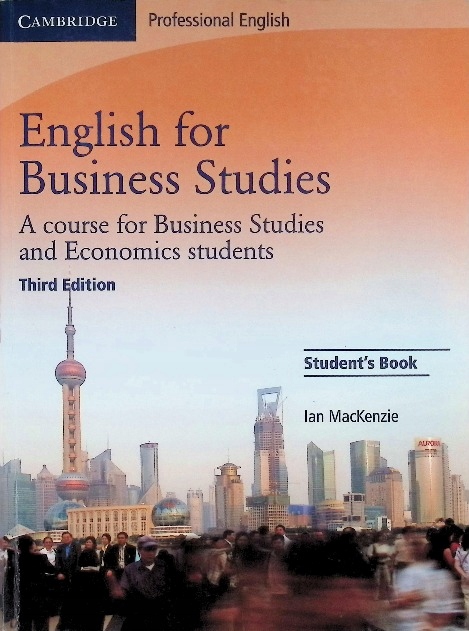Aims of the course:
- improvement and development of all the language skills acquired on lower levels
- expansion of lexis and lexical structures used in the business context
- expansion of grammatical structures used in the business context
- development of business communication skills (soft skills)
- acquisition of the ability to use English for academic and professional purposes
- development of learning strategies and self-evaluation of student's language skills
- Teacher: Bartosik Ewa
The aim of the course is to:
- improve and development of all the language skills acquired at lower levels
- expand lexis and lexical structures used in the business context
- expand grammatical structures used in the business context
- develop business communication skills (soft skills)
- acquire the ability to use English for academic and professional purposes
- develop learning strategies and self-evaluate student's language skills
Throughout the course the main topic areas include:
Semester I:
- Management,
- Work and motivation,
- Managing across cultures,
- Marketing,
- Market structure and competition,
- Banking,
- Business correspondence.
Semester II:
- Meetings,
- Takeovers,
- Government and taxation,
- The business cycle,
- Corporate social responsibility,
- International trade,
- Networking skills
- Effective discussions
- Communicating at the workplace.
Lexical and grammatical structures include :
Semester I:
- The use of tenses when communicating ideas and summarising
- The use of conditionals when communicating ideas and summarising
Semester II:
- The use of passive voice when communicating ideas and summarising
- The use of linking devices and text organizers when communicating and summarising
Language functions/effective communication include :
- Giving short presentations summarising students’ points of view on the given topic
- Giving feedback to peers
- Expressing opinions and presenting arguments
- Reacting properly in social situations
- Written and oral analysis of business-related text and recordings
- Analysis and selection of information
- Drafting effective business documents and correspondence
- Using professional language connected with students’ field of studies
- Searching for, processing and evaluation of information, the ability to make notes from lectures, books, articles etc.
- Developing language competences and improving skills needed to study at the universities abroad
- Preparing presentations of professional materials connected with the students’ field of studies
- Functioning in the situations typical for the academic environment: participation in a lecture in the target language, discussion, presentation, academic debate
- Developing the skills connected with the academic environment of other countries – being sensitive to cultural differences
- Developing the autonomy among others through defining the style of learning and using appropriate strategies (forming one’s own opinions and presenting them)
- Teacher: Bartosik Ewa
The aim of the course is to:
- further develop communicative competencies in English
- enhance vocabulary range and explore complex grammatical structures
- further enable students to use English in academic and professional settings
- help present student’s personal standpoint in speech and writing in a clear and coherent manner
- foster self-education learning strategies
- promote team work
Throughout the course the main topic areas include:
Semester 1
- Loans and credit
- Corporate Finance: Stocks, shares and bonds
- Derivatives: futures, forwards, options and swaps trading
- Company Law, AGMs
- The money market
- Business correspondence: letters/emails of enquiry; layout, register (formal, semi-formal, informal)
Semester 2
- Negotiations
- Mergers and Acquisitions, leveraged buyouts
- Asset management
- Business correspondence: internal emails
- Business correspondence: cover letters
Lexical and grammatical structures include :
Semester 1
- Active/passive voice
- Reported speech
- Time clauses
Semester 2
- Language of negotiations: making proposals, counter-proposals and conditional offers
- Grammar revision
Language functions/effective communication include :
- carrying out negotiations related to their field of study
- giving feedback to peers
- expressing opinions and presenting arguments
- reacting properly in social situations
- analysing business-related texts and recordings
- analysing and selecting information
- drafting effective business documents and
- correspondence
- using professional language connected with students’
- field of studies
- giving advice and solving problems
- describing numerical information
- analysing, synthesizing and comparing information
- participating actively in typical academic settings: discussions, negotiations, etc.
- reading for understanding and synthesis of information from a variety of texts
- writing letters and external & internal emails
- finding, selecting, and presenting information
- Teacher: Bartosik Ewa
The aim of the course is to:
• further develop communicative competencies in English
• enhance vocabulary range and explore complex grammatical structures
• further enable students to use English in academic and professional settings
• help present student’s personal standpoint in speech and writing in a clear and coherent manner
• foster self-education learning strategies
• promote team work
Main topic areas include:
Semester I:
• Financial environment
• Different types of banks and banking products, role of central banks
• Bank loans and credit
• Saying numbers in English
• Business correspondence – letters and emails: layout, register (formal, semi-neutral, informal), letters/emails of complaint and apology (option: circular letters)
Semester II:
• Presentations – basic functions: language, content, delivery; visual aids, body lg, handling questions
• Different types of accounting
• Reporting company performance: financial statements, performance forecast
• Graphs, charts and price changes
• Business correspondence: emails chasing payment
- Teacher: Bartosik Ewa







